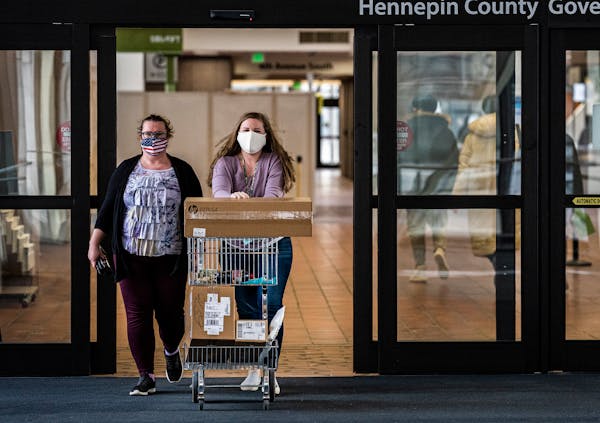An explosion of COVID-19 cases in Minnesota the past two months did not produce a comparable increase in deaths, which are declining as the state emerges from consecutive pandemic waves.
The one-week average of COVID-19 deaths steadily declined from 39 per day on Dec. 2, when a fast-spreading delta coronavirus variant was dominant, to 22 per day on Feb. 11, according to Minnesota's latest COVID-19 data released Thursday. Counts of COVID-19 deaths on more recent dates are only preliminary because of the lag in verifying and reporting them, but they appear to show a continuing decline as well.
State leaders credited Minnesota's successful vaccination campaign, which has resulted in 55.6% of 3.8 million fully vaccinated people receiving booster shots against the coronavirus that causes COVID-19. The booster rate ranks second among the states, according to the U.S. Centers for Disease Control and Prevention.
"The sheer number of folks we have with boosters during omicron, the data suggest saved immense number of lives," Gov. Tim Walz said in an interview.
The unusual arc of the pandemic in Minnesota the past six months also likely played a role in reducing omicron's death toll.
Nationally, the fast-spreading omicron variant played out as feared. While it didn't cause as high a rate of severe illness as the previous delta variant, it caused so many more infections that the total number of deaths rose anyway. The delta wave peaked in the U.S. at a one-week average of 2,390 deaths per day on Sept. 15, while the omicron wave peaked at 2,597 deaths per day on Feb. 2.
In Minnesota, the delta variant by comparison spread much later and lasted much longer, making it difficult to know when the state's delta wave ended and the omicron wave began. The result was many Minnesotans had immunity built up from the prolonged delta wave as well as vaccinations, giving them a layer of protection against omicron that wasn't as strong in other states, said Michael Osterholm, director of the University of Minnesota's Center for Infectious Disease Research and Policy.
"We led the country for multiple weeks over October and early November in terms of the incidence of delta here in Minnesota compared to other states," he said. "So we were taking on a lot of incoming virus at that time, and that surely we know had some impact on serious illness" levels in the subsequent omicron wave.
Thursday's state data still showed the risks of coronavirus infection, verifying 47 more COVID-19 deaths in February and one from January. The update included three Minnesotans in their 40s and raised the state's COVID-19 death toll to 12,066.
People younger than 60 made up only 8% of Minnesota's COVID-19 deaths reported by Nov. 1. Since then, they have made up nearly 19% of the state's COVID-19 deaths, mostly because the rate of vaccination declines by age group in the state.
COVID-19 remains several times more lethal than influenza, making it important for people to still seek vaccines and booster doses, said Curtis Storlie, a co-creator of Mayo Clinic's 14-day predictive model of COVID-19.
"I don't think we are quite there yet to treat it just like flu, although I know many people want to and already are," he said. "If 80-90% of the population were boosted right now, it would likely drag the per case severity down low enough to proclaim it 'just like the flu.'"
All signs point toward an end of the omicron wave. The state's reported positivity rate of COVID-19 diagnostic testing yo-yoed from 8.6% in the two weeks ending Dec. 20 to a record 23.5% on Jan. 10 to 7.2% on Feb. 15. It soon could drop below the state's 5% caution threshold for substantial viral spread for the first time since Aug. 2.
COVID-19 hospitalizations in Minnesota rose from 1,319 at the start of 2022 to 1,629 on Jan. 19 but declined to 601 on Wednesday.
COVID-19 hospitalizations requiring intensive care never increased during the omicron wave, dropping consistently from 374 on Dec. 16 to 93 on Wednesday. That trend matched the state's slowly declining number of deaths per day during the wave.
Charges: Man picked out woman's St. Paul home at random, raped her at gunpoint and robbed her
Gunfire from vehicle kills 14-year-old in SUV at northeast Mpls. gas station

